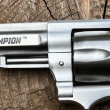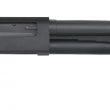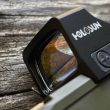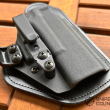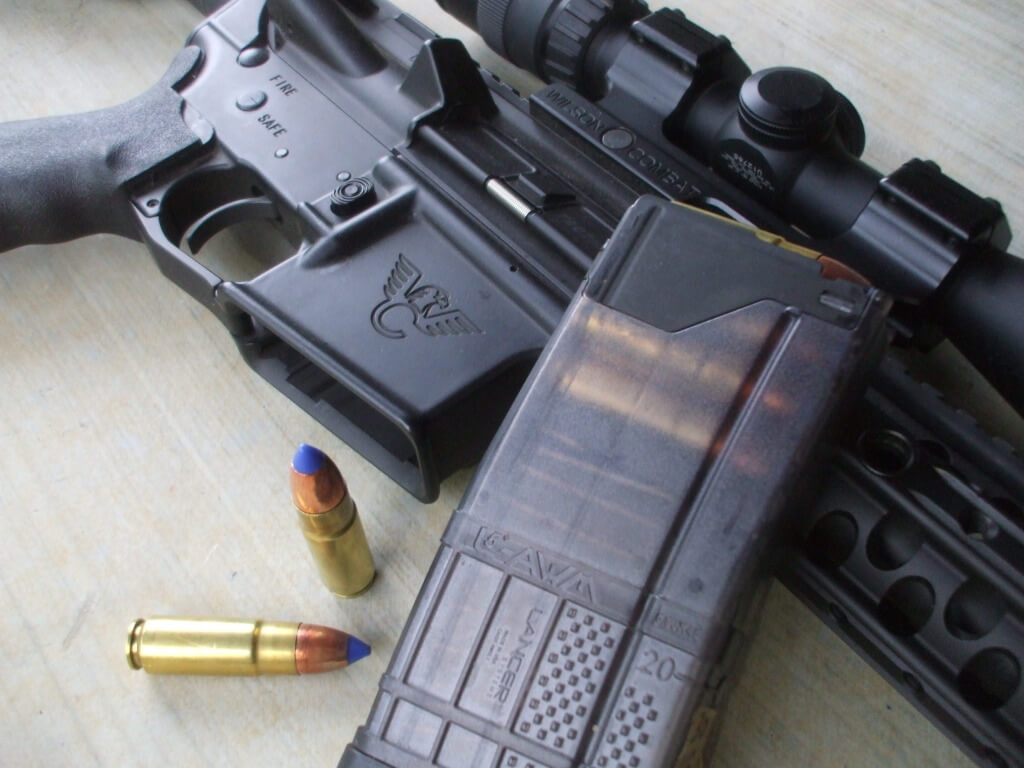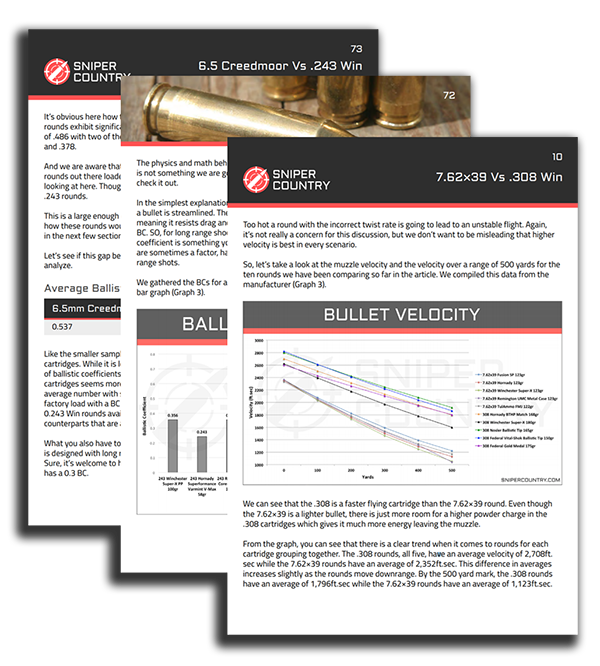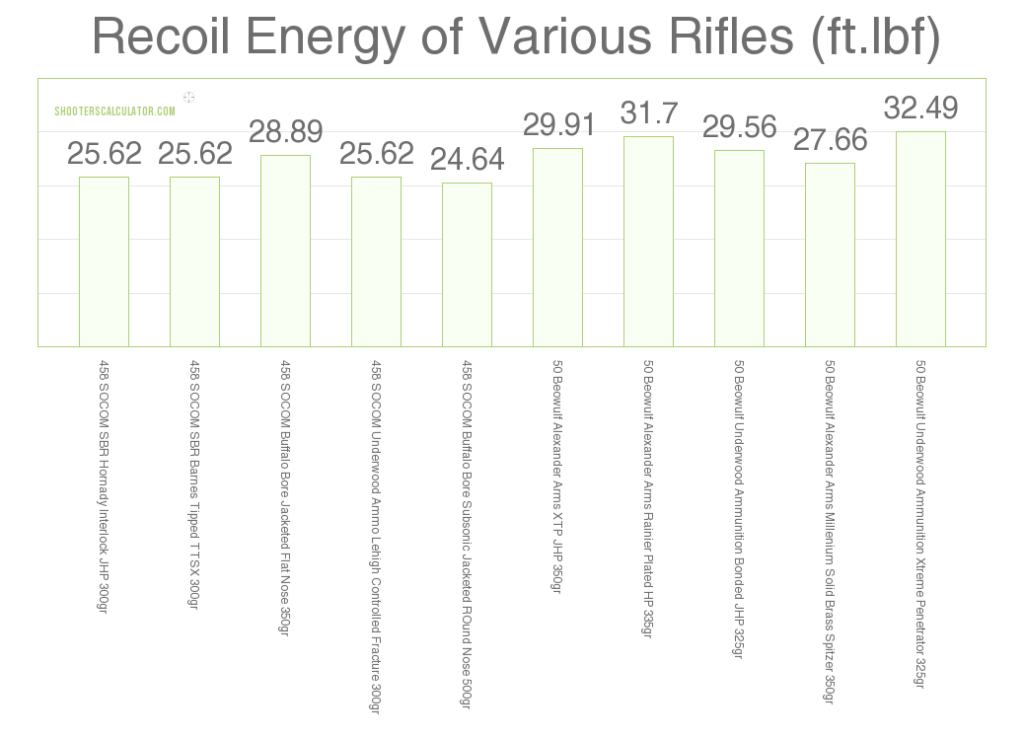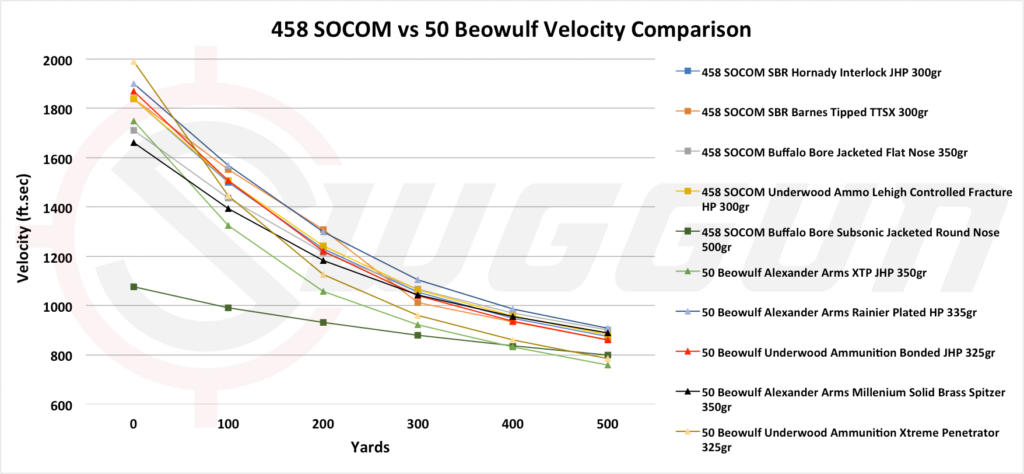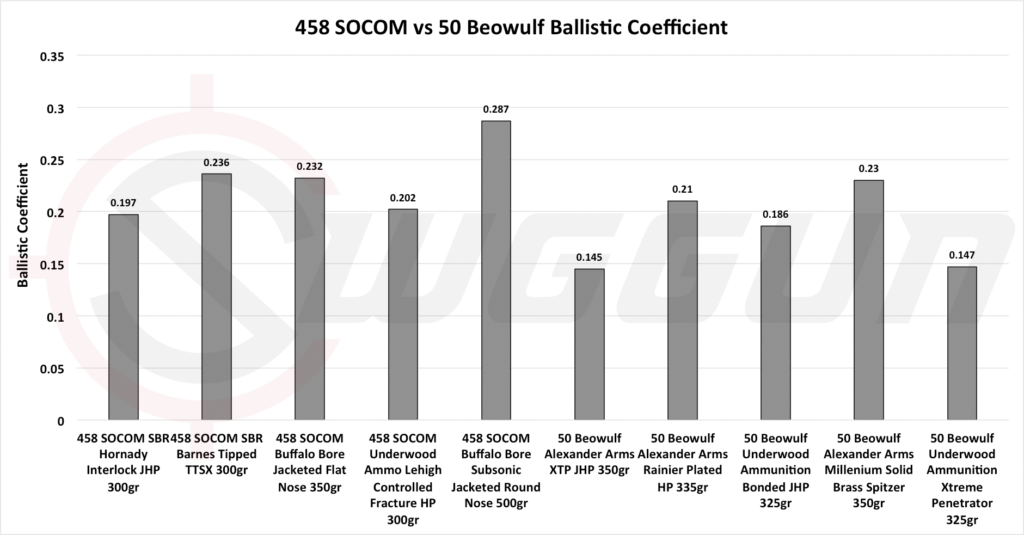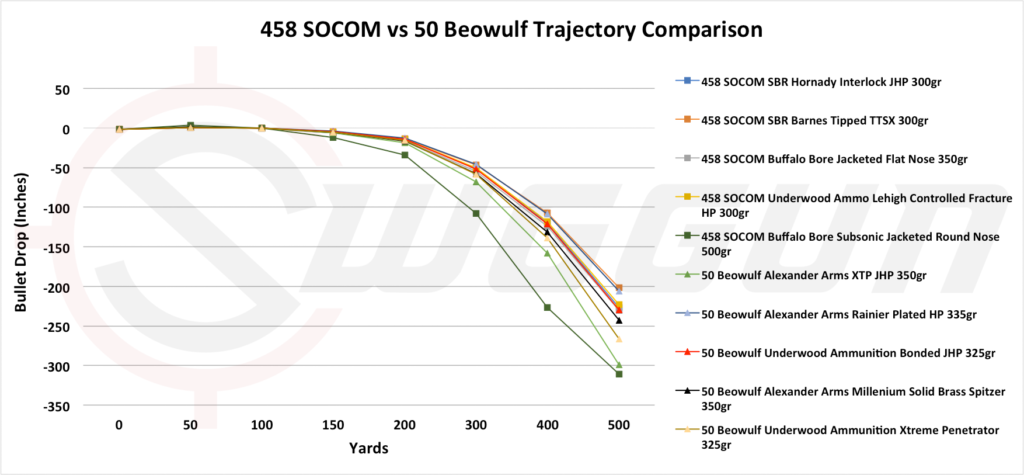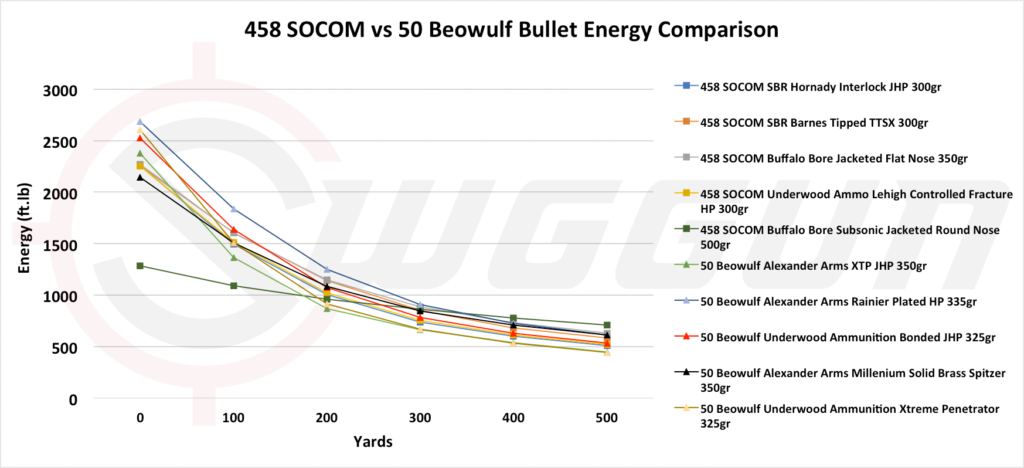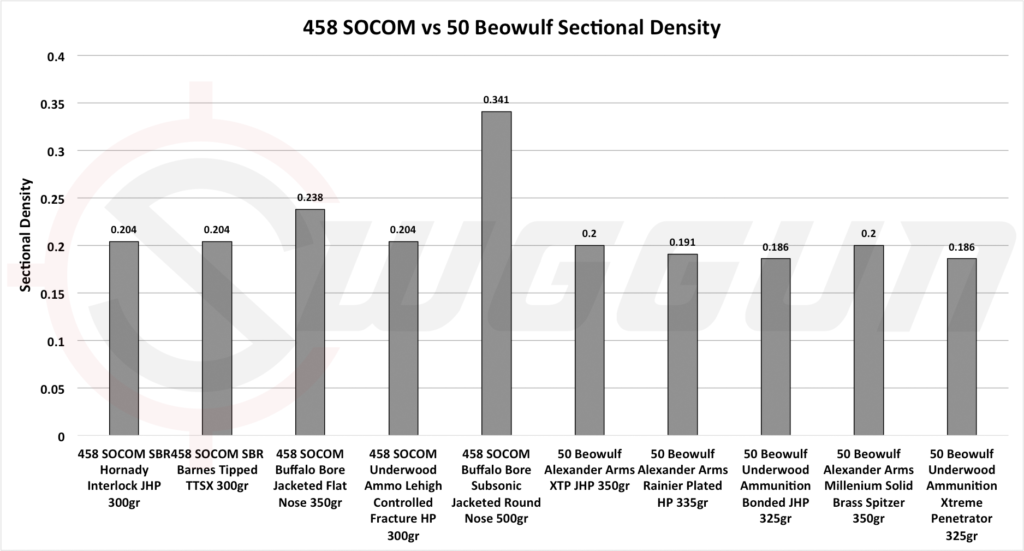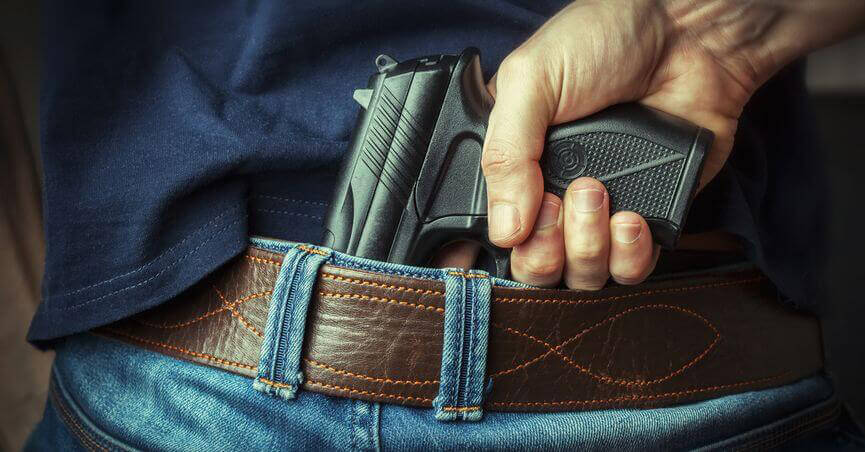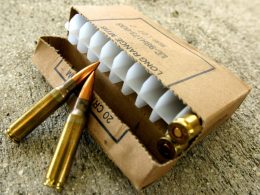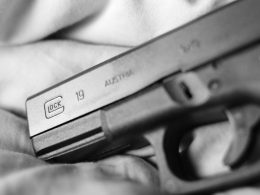In this Article:
In this comparison of the .458 SOCOM and .50 Beowulf cartridges, we will examine how these two competing rounds, which frequently target the same shooting niches, measure up against each other across various ballistic and performance criteria.
Since both cartridges have many similarities, determining which one is superior can be straightforward. However, our goal in this article is different. Instead of declaring one cartridge as better than the other, we aim to present an impartial analysis of both. This will allow you to make a more informed decision based on the data provided.
Ultimately, choosing the right cartridge often boils down to personal preference after experiencing both options. There will be plenty of debate about which cartridge is better, but our focus here is strictly on quantifiable aspects. We won’t delve into factors like the availability of components, how smoothly they feed, or other logistical considerations.
In the end, the decision often hinges on which cartridge you feel most confident using, especially when dealing with two rounds that are quite similar.
A Brief History
.458 SOCOM
The .458 SOCOM was created with a specific mission in mind. As its name suggests (Special Operations Command), it was developed because special operations forces were dissatisfied with the 5.56 rounds’ effectiveness in quickly neutralizing threats with minimal shots when using platforms like the M4 and M16.
After deliberations and experimentation, the .458 SOCOM came to be in the early 2000’s. This 40mm long case was designed to be fitted with the much larger .458 diameter bullets that produce dramatically more force than the 5.56 rounds but still able to be used with an AR magazine and a specialized .458 SOCOM upper receiver.
The .458 SOCOM has gained traction in the civilian shooting community, especially among AR enthusiasts and hand loaders. It is praised as a formidable low-velocity home defense round and an effective brush gun. Several companies produce factory-loaded .458 SOCOM ammunition, although availability is somewhat limited. These rounds generally come in bullet weights ranging from 300 to 500 grains, with options for subsonic ammunition also available.
.50 Beowulf
Similar to the .458 SOCOM, the .50 Beowulf cartridge was designed and produced in the early 2000’s with the idea to generate a large bore cartridge that could be used in the AR-15/M16 style weapons that traditionally are chambered for the 5.56×45 rounds. The reason was again because of the low stopping power with the traditional rounds, and a large, .50 cal cartridge gave the promise for a round with devastating power in close quarters to mid range shots.
The combination of a round with performance specs similar to the highly regarded .45-70 cartridge and a semi-auto tactical platform was advantageous to both military and police personnel who often found themselves in close quarters situations with a need to bust through cover and neutralize targets quickly.
The cartridge has obviously become popular with self-defense communities, but its performance has also found a place in the hunting world, especially in tight and overgrown situations. Factory loads for the .50 Beowulf are lacking compared to other cartridges but is slowly gaining traction. Most bullet weights fall in the 300-350gr category, and there are much larger options available for subsonic rounds.
Specs
| .458 SOCOM | .50 Beowulf | |
|---|---|---|
| Parent Case | .50 Action Express | .50 Action Express |
| Bullet Diameter | .458†| .500†|
| Neck Diameter | .485†| .525†|
| Base Diameter | .541†| .535†|
| Case Length | 1.575†| 1.65†|
| Overall Length | 2.260†| 2.125†|
| Case Capacity | 61.1gr | 65.8gr |
As demonstrated, both of these large-bore cartridges are significantly larger than the typical 5.56 round. They share fairly comparable dimensions, though one notable difference not shown in our table is that the .458 SOCOM round is tapered, whereas the .50 Beowulf is not. This tapering might affect how smoothly the cartridges cycle.
Neither cartridge has an official SAAMI rating for case capacity or maximum pressure, and handloading references vary. The averages for maximum capacities from reliable sources indicate that both cartridges hold similar amounts of powder and are loaded with comparable bullet weights. Although there is no formal rating body, hand loaders generally adhere to a maximum pressure of 35,000 psi for both rounds.
Both cartridges occupy a specific niche in the shooting world, leading to limited factory load options compared to more widely used defense and hunting rounds. Nonetheless, to facilitate this comparison, we have selected five rounds of each cartridge and listed them below.
 .458 SOCOM SBR Hornady Interlock JHP 300gr
.458 SOCOM SBR Hornady Interlock JHP 300gr .458 SOCOM SBR Barnes Tipped TTSX 300g
.458 SOCOM SBR Barnes Tipped TTSX 300g .458 SOCOM Buffalo Bore Jacketed Flat Nose 350gr
.458 SOCOM Buffalo Bore Jacketed Flat Nose 350gr .458 SOCOM Underwood Ammo Lehigh Controlled Fracture HP 300gr
.458 SOCOM Underwood Ammo Lehigh Controlled Fracture HP 300gr .458 SOCOM Buffalo Bore Subsonic Jacketed Round Nose 500gr
.458 SOCOM Buffalo Bore Subsonic Jacketed Round Nose 500gr
 .50 Beowulf Alexander Arms XTP JHP 350gr
.50 Beowulf Alexander Arms XTP JHP 350gr .50 Beowulf Alexander Arms Rainier Plated HP 335gr
.50 Beowulf Alexander Arms Rainier Plated HP 335gr .50 Beowulf Underwood Ammunition Bonded JHP 325gr
.50 Beowulf Underwood Ammunition Bonded JHP 325gr .50 Beowulf Alexander Arms Millennium Solid Brass Spitzer 350gr
.50 Beowulf Alexander Arms Millennium Solid Brass Spitzer 350gr .50 Beowulf Underwood Ammunition Xtreme Penetrator 325gr
.50 Beowulf Underwood Ammunition Xtreme Penetrator 325gr
Before diving into our comparisons, there’s one additional point to address. The data we are using comes from manufacturer websites and trusted ballistic calculators. We ensure transparency about the variables and methods used when employing ballistic software.
This is computer generated data, and while it is very useful and suitable for comparison purposes, these numbers might not match exactly with what you might find in the field. Each rifle has unique characteristics, and various environmental and physical factors can cause variations in performance. Nonetheless, these discrepancies are typically minor and do not detract from the overall purpose of comparing the .458 SOCOM and .50 Beowulf.
One more thing to note before we begin. We are examining a range of categories isolated from other influencing factors. In ballistics, all aspects are interconnected—velocity affects certain characteristics and is influenced by others. As we proceed with this comparison, remember that terminal ballistics encompass more than just kinetic energy or sectional density. For clarity and to avoid getting bogged down, we’ll address each category individually but will integrate the findings when discussing practical applications.
Now, let’s get started.
Recoil
Whether you’re considering these rounds for hunting, home defense, or competition, recoil plays a crucial role in any shooting scenario. While neither of these rounds will knock you off your feet, in lighter AR platforms used for competition, home defense, or some hunting situations, managing recoil is important for maintaining rapid follow-up shots.
We’ll compare the actual recoil energies of these two cartridges. Although this is not the same as the felt recoil you experience when shooting, higher recoil energy typically results in more perceived kick. Since felt recoil varies greatly with firearm features like suppressors, barrel length, and stocks, we’ll focus on the actual energy (ft.lb) generated by firing the rounds.
Even these numbers can change depending on the variables such as powder charge, type of powder, and firearm weight. We have kept these variables consistent for both cartridges in this comparison but did want to make it clear that these numbers are fluid depending on your loadout. Still, these numbers give you an idea of how these two cartridges stack up against each other.
We have used a 7lb firearm in the equation as well as a powder charge of 40gr for all of the selected rounds and presented the results here.
We see that all of the selected rounds fall into the range of 24-32ft.lb of recoil energy which is quite a wide range. The .458 SOCOM rounds have slightly lower recoil energies when compared to the .50 Beowulf, which has several rounds in the 39-32ft.lb range compared to the highest .458 SOCOM round at 28.89ft.lb.
All of these rounds are in the 300-350gr range besides the single subsonic .458 SOCOM round which is 500gr. They also have the same powder charge and firearm weight, so why the increased recoil energy for the .50 Beowulf rounds? It has to do with the muzzle velocity of the rounds that we put into the calculation which came from the manufacturer’s website and a point of interest that we will look at in an upcoming section.
Although we’ve noted that these numbers can fluctuate due to various factors, the recoil generated by these cartridges is significant enough that firearm modifications might be necessary to manage them effectively and efficiently for the shooting scenarios where these cartridges are most effective.
Ballistics
Although neither of these cartridges excels at long-range performance, analyzing several ballistic factors such as velocity, ballistic coefficients, and trajectory can still provide valuable insights. Both rounds are used for range shooting as well as hunting, making these aspects relevant. Understanding the behavior of these bullets is crucial for making precise adjustments and recognizing the limitations of each cartridge.
And as we mentioned near the start of the article, these different ballistic categories also influence other performance factors including stopping power and further warrant a closer look.
Velocity
When looking at the .50 Beowulf vs .458 SOCOM, especially when it comes to velocity, we have to remember that both of these rounds are low velocity even when not subsonic. Typically, velocity plays a crucial role in hunting and self-defense due to its effects on performance at long range, expansion, and penetration. While these factors still apply, they might be less critical for those using these rounds compared to F-class competition shooters.
These large-diameter, heavy-hitting cartridges are designed primarily for close-quarters situations where extensive expansion may not be desirable. They possess sufficient velocity to penetrate targets and perform effectively in cover situations, but it’s important to acknowledge the context in which these rounds are used.
We have collected the velocity (fps) data for all of these rounds from the muzzle out to 500 yards.
One notable observation is that all the rounds lose velocity relatively quickly, which aligns with their design for closer-range shooting rather than 400 or 500 yards. There’s no clear trend indicating that one cartridge consistently maintains higher or lower velocities compared to the other. Initially, the .50 Beowulf rounds exhibit higher muzzle velocities, but this advantage diminishes rapidly.
If we take the averages of the rounds for each cartridge we see that there is never more than 100ft. lb difference between the two. This is without factoring in the subsonic .458 SOCOM round. Below we have listed the average velocities for each cartridge out to the 300-yard mark and have omitted the subsonic .458 SOCOM round.
Average Velocity (ft/s)
| .458 SOCOM | .50 Beowulf | |
|---|---|---|
| Muzzle | 1807 | 1834 |
| 100yds | 1498 | 1448 |
| 200yds | 1248 | 1177 |
| 300yds | 1049 | 1014 |
As we have said several times, these are lower velocity rounds, for rifle cartridges, and all of the rounds fall below supersonic speeds by the 300-yard mark which is the upper limit for the range of these cartridges. From 0 to 200 yards, the velocities remain supersonic for the majority of the cartridges.
Ballistic Coefficient
The ballistic coefficient is derived from an equation that uses several bullet and cartridge variables and may or may not have any relevance to you. A few of these include the bullet design and the speed of the bullet. The math and physics behind the ballistic coefficient (BC) can get quite complex, but it’s definitely worth exploring if you’re curious, as it’s fascinating. In this article, however, we’ll stick to the basics to keep things simple. The ballistic coefficient essentially measures how well a bullet can cut through the air. A higher BC means the bullet is more resistant to wind drag and drift, making it less prone to being knocked off course and, in theory, more accurate.
For the .458 SOCOM versus the 50 Beowulf comparison, the BC might not have the same relevance as it would for more long range cartridges. We are dealing with two cartridges that were designed for close quarters situations
Even while these rounds might not be used in long range capacities (300+ yards) we still think it is important to discuss the BC for those who still might be interested but because it also influences our next section.
We have collected the BCs for all ten rounds from the manufacturer’s website and listed them here.
From the factory loads that we have selected, there appears to be a trend towards the .458 SOCOM rounds showing better ballistic coefficients than the .40 Beowulf rounds. Granted, not one round cracks the .3 mark. Four of the five .458 SOCOM rounds break the .2 mark while only to .50 Beowulf round do so, and they also have two rounds below the .15 mark.
While this sample size is small, it reflects the limited factory-loaded options available. However, handloading could enhance the BC by utilizing bullets not currently available in factory loads.
The lower BCs are consistent with the design goals of these rounds: to deliver substantial force at close range. The bullets are often rounded or flat-nosed, which are less drag-resistant. While the numbers are much lower than say a .338 LM round, for their purpose, these numbers shouldn’t cause any alarm. And like most ballistic numbers, environmental conditions can change these slightly from day to day based on temperature and pressure, among others.
The BC is most known to influence a bullet’s trajectory so let’s take a look at this in our next section.
Trajectory
Although these rounds are not designed for long-range use, their trajectory remains crucial for mid-range shooting, which encompasses both home defense and hunting scenarios. This section focuses on how much the bullet drops during its flight. A flatter trajectory (i.e., less bullet drop) is advantageous as it reduces the need for significant adjustments to shot placement. In practical situations—whether using open sights, holo sights, magnifiers, or traditional scopes—home defense and hunting often don’t allow for precise distance readings or adjustments. A flatter trajectory can help compensate for minor errors in these scenarios.
In the case of the .458 SOCOM vs .50 Beowulf, we are not going to mess around with the trajectory over 500 yards. Even 500 yards might be overkill, but it was a nice round number. Throughout this range, we are comparing the bullet drop, in inches, of our ten selected rounds for comparison.
From the muzzle out to 150yds, there is no difference between these two cartridges. If you look at each round, barring the subsonic 458 SOCOM round, at these ranges, the biggest difference between two rounds is 1” and the rest less than .5”. As the rounds move out to the 200 and 300 individual rounds, do begin to distance themselves from one another. Below we have listed the averages for each cartridge out to 300 yards.
Average Bullet Drop (Inches)
| Yards | .458 SOCOM | .50 Beowulf |
|---|---|---|
| 150 | 5.5†| 5†|
| 200 | 14.2†| 15†|
| 300 | 50.8†| 54.4†|
From the averages alone, we see that both of these cartridges are nearly identical when it comes to the flatness of their trajectory at 150yds. The gap widens slightly between cartridges at the 200-yard mark where the .458 SOCOM nearly an inch less bullet drop than the .50 Beowulf which is not going to be a point of concern for most people. At the 300 yard mark, we see the biggest difference between the cartridges with a little over four inches of difference with the .458 SOCOM round having the flatter of the trajectories. Again, most wouldn’t put too much stock in four inches of difference between these two cartridges, but the data is there.
As you can see, 300+ yards is going to offer some difficult shooting for even skilled marksmen. We also have not mentioned the subsonic 458 SOCOM round up to this point which takes a dive past the 300 yard mark, but it’s not an issue as subsonic rounds are almost exclusively used for close range applications.
Though there is a slight trend for the .458 SOCOM being a bit flatter in its trajectory, both cartridges have rounds that perform better and more poorly in this specific area. Overall, we wouldn’t give an edge to one cartridge over the other in this category.
Stopping Power
For hunters and those selecting a self-defense cartridge, stopping power is a crucial consideration. In hunting, especially with predators, being able to take down an animal quickly and cleanly is important to minimize danger and ensure a humane kill, avoiding unnecessary suffering and the risk of losing the animal. In self-defense scenarios, the need for a round with substantial stopping power is equally clear.
Stopping power involves several elements, including bullet energy, penetration, bullet expansion, and shot placement. Here, we’ll focus on bullet energy and penetration to compare how the .458 SOCOM and .50 Beowulf measure up in terms of stopping power. While these are just two factors of many, they provide a good basis for comparing the effectiveness of these cartridges.
Energy
When a bullet is launched from the barrel down range (best .458 SOCOM barrels), it carries a kinetic energy along with it. This kinetic energy is derived from the mass and the velocity of the bullet. When the bullet reaches the target, this energy is transferred and causes a tremendous amount of damage to the surrounding tissue and organs.
The energy needed to take down an animal or neutralize a target varies, as does the energy transferred to the target. However, all the rounds on this list should be effective at close range and capable of taking down medium-sized game within reasonable distances. For those comparing the .458 SOCOM and .50 Beowulf, we will examine the kinetic energy (in ft.lb) of each selected round to aid in the decision-making process.
As with our previous analyses, we have graphed the kinetic energy data up to 500 yards but will focus our discussion on 300 yards, which is the effective range for most users of these cartridges.
From the muzzle, the most noticeable trend between these two rounds presents itself. At this point, the .50 Beowulf rounds, besides ones, show higher bullet energies than the .458 SOCOM rounds. At this point, the average for the .458 SOCOM is 2,064ft.lb while the .50 Beowulf is 2,467ft.lb. The gap closes at the 100-yard mark with the rounds much more tightly clustered. The highest performing round at this mark is still a .50 Beowulf, but the averages begin to look similar. The .50 Beowulf average at this mark is 1570ft.lb while the .458 SOCOM average is 1,462ft.lb.
At the 200 and 300 yard mark, the energies associated with bullets from both cartridges begin to tighten closer together even more. The averages for the 200 and 300 yard mark for both cartridges are 1,052 and 800ft.lb for the .50 Beowulf and 1,056 and 810ft.lb for the .458 SOCOM rounds.
Although these averages provide a snapshot of the differences, it’s important to note that individual rounds from both cartridges show a range of kinetic energy values.
Penetration
Another factor that goes into a cartridge’s stopping power is the penetration of the bullet. To be effective, a bullet must be able to penetrate through sometimes very thick hide and bone to reach vital organs. Of course, how much penetration you need is going to depend on the game you are hunting.
Penetration is also crucial for self-defense scenarios, where an intruder might be wearing protective clothing. A self-defense round must be able to penetrate these barriers effectively. However, there is a balance to be struck; too much penetration with high velocity and minimal expansion could result in the bullet passing entirely through the target and posing a risk to others nearby.
Additionally, while we’ve simplified the topic by excluding bullet expansion—an important factor that affects both the size of the wound and the energy transfer to surrounding tissue—it’s worth noting that expansion plays a significant role in overall effectiveness.
Without ballistic gel data, and considering that bullet type affects performance within each cartridge, we’ll use sectional density as a proxy. Sectional density, calculated from the bullet’s diameter and weight, helps estimate penetration. Heavier bullets of the same diameter will generally penetrate deeper than lighter ones. Likewise, a smaller diameter bullet with the same weight focuses the force on a smaller area, enhancing penetration.
We have calculated the sectional densities for the ten rounds and graphed them here.
From our description of what sectional density is and given that both of these cartridges use similar weight bullets, these numbers make a lot of sense. The slightly smaller diameter of the .458 SOCOM rounds bumps up their sectional density slightly when compared to the .50 Beowulf rounds. We also have a good example of how weight affects the SD when we look at the 500gr subsonic .458 round that has an SD of .341.
And again, we’re taking a lot out of the picture when it comes to penetration and rest assured that these rounds are not going to plink off a target. It’s simply not what they are designed to do, but there is a distinction between these two cartridges when it comes to the potential penetration.
Accuracy
Accuracy comparisons between cartridges can ignite debates as intense as political discussions. Personal preference often skews perceptions of accuracy, making it a subjective topic. Ideally, accuracy should be measured under identical conditions with the same shooter, using consistent MOA data.Â
Even then, how consistent would this data be? There is great information out there that has been compiled by expert shooters, but does their data correlate to your skill level?
Maybe and maybe not, but the best way to determine accuracy is to test it out yourself. That’s not always easy and can cost quite a bit of money, but we can look back at previous ballistic data and try a roundabout way to look at accuracy between the 458 SOCOM vs 50 Beowulf cartridges.
When it comes to the ballistics, we saw that both of these cartridges have very similar profiles. They both have rounds that perform more efficiently in each category, but there were some very slight differences when comparing the two. And even then, when it comes to shots within 100 yards, we don’t think one cartridge has any advantage over the other to accuracy.
If you are planning on shots coming outside of the 1oo yard mark, the .458 SOCOM round did have slightly higher velocities, higher BCs, and a flatter trajectory than the averages of the .50 Beowulf rounds. We find it difficult to say that this small difference would lead to a difference in accuracy, but in theory, the higher performing .458 SOCOM rounds should be easier to put on target at greater distances than the .50 Beowulf.
We also have to bring recoil into the discussion. The .50 Beowulf rounds had on average, several more ft.lb of force than the .458 SOCOM rounds. Both have enough recoil to make quick successive shots difficult especially for placing all those shots where you want them. Of course, with some tinkering with your rifle, you can make this recoil much more manageable.
Special Offer: Join our private community and get exclusive gun deals, handpicked gear recommendations and updates on law changes, every day!
Join our private community
Price and Availability
Price is a significant consideration when choosing between cartridges, though it shouldn’t be the sole factor. While both cartridges have their more affordable and more expensive options, the .458 SOCOM is is more expensive per round than the .50 Beowulf. You have seen the performance specs, and if nothing stood out to you in those areas, it might come down to price for you. Of course, if you do decide to hand load, the price per round will go down significantly and save you quite a bit over time.
Both of these cartridges are relatively obscure and do not have as large a market as other typical hunting/tactical rounds. Because of this, their availability is often limited if you are searching in retail stores. You might come across them, but the selections for both are going to be limited. Of course, with the internet, you are going to be able to get your hands on whatever you need, but it might take more time. From our experience, these rounds are more often than not in stock through online retailers.
| Ammunition | Price (20 Rounds) |
|---|---|
| 458 SOCOM SBR Hornady Interlock JHP 300gr | $45.30 |
| 458 SOCOM SBR Barnes Tipped TTSX 300g | $59.99 |
| 458 SOCOM Buffalo Bore Jacketed Flat Nose 350gr | $46.71 |
| 458 SOCOM Underwood Ammo Lehigh Controlled Fracture HP 300gr | $59.99 |
| 458 SOCOM Buffalo Bore Subsonic Jacketed Round Nose 500gr | $54.99 |
| 50 Beowulf Alexander Arms XTP JHP 350gr | $29.49 |
| 50 Beowulf Alexander Arms Rainier Plated HP 335gr | $27.99 |
| 50 Beowulf Underwood Ammunition Bonded JHP 325gr | $25.49 |
| 50 Beowulf Alexander Arms Millennium Solid Brass Spitzer 350gr | $42.99 |
| 50 Beowulf Underwood Ammunition Xtreme Penetrator 325gr | $36.49 |
Applications
We’ve examined various ballistic and performance aspects in the .50 Beowulf vs .458 SOCOM comparison, and both cartridges demonstrate strong capabilities across different shooting scenarios.
For self-defense, both cartridges are effective. They offer impressive stopping power from an AR platform and have the necessary velocities to penetrate thick hide, cover, and even body armor. Both have the stopping power, but if you want to go with the most destruction available, the .50 Beowulf rounds have slightly higher ft.lb of energy behind them at close ranges and the large .50 cal bullet is going to be brutal.
Of course, the increased recoil of the .50 Beowulf might make successive shots more difficult to put on target when compared to the .458 SOCOM. Both of these cartridges have rounds designed specifically for this purpose as well to provide maximal damage at close range.
In hunting scenarios, both cartridges serve well as brush guns for medium-sized game, particularly in heavy cover where shots are often close-range. Both rounds are effective even at longer distances.
The slightly better BCs and the higher average velocities out at 100 and 200 yards might sway you towards the .458 SOCOM rounds when it comes to hunting purposes. While you might get in closer in some situations where this difference is negated, we think it’s better to think about hunting medium sized game and choosing the cartridge with 75+ yards in mind.
Both cartridges provide ample penetration and energy to cleanly take down game up to 200 yards. They offer hunting options that enhance expansion for better energy transfer. While all rounds examined drop below the 1,000 ft.lb mark at 300 yards, there remains sufficient energy to effectively harvest medium-sized game with a well-placed shot, especially given the size of these rounds.
Best Rounds
Before we move on and wrap up this cartridge comparison, we wanted to select a round for each cartridge that we think we excel in certain shooting scenarios. We don’t necessarily think it’s the only option for the job, but we are confident it will get it done.
Top Hunting Round
For the .458 SOCOM, we like the SBR Barnes Tipped TTSX 300gr round. It has some of the best ballistic properties available for factory loaded .458 SOCOM rounds and has more than enough bullet energy, penetration, and expansion for excellent stopping power for medium size game out to 300 yards.
For the .50 Beowulf, the Alexander Arms Rainier Plated HP 335gr is one of our favorite hunting rounds. It does not have the expansion of our choice for the .458 SOCOM, but what it does have with the .50 cal bullet is enough to make clean kills up to 300 yards, and the trajectory is extremely flat when compared to other
Top Defense Round
Our recommendation for a defense round for the .458 SOCOM goes to the Buffalo Bore Subsonic Jacketed Round Nose 500gr. For in home defense and other close quarters scenarios, the subsonic round is perfect for reducing noise and flash that can be disorienting to the user. On top of that, the heavy grain bullet paired with the velocity at close range is going to neutralize threats quickly and the recoil is also extremely manageable.
Conclusion
The debate between .458 SOCOM and .50 Beowulf is likely to continue as enthusiasts weigh their options. We trust that this article has provided a balanced comparison of several factory loads, offering insight into how they measure up in different ballistic and performance aspects.
There are additional factors to consider when choosing between these two cartridges that we haven’t covered, which might influence your final decision. While we’ve provided a comprehensive overview, gaining hands-on experience with both cartridges is highly recommended if possible. Both rounds are capable of fulfilling your needs, but ultimately, your choice will come down to which one you feel most confident using based on practical experience.

